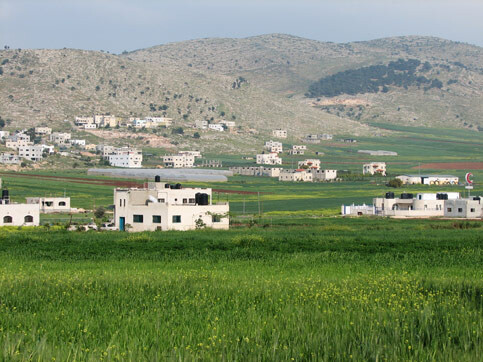Jordan Valley 22 January 2008

The hills east of Tubas village leading into the Jordan Valley. (Anna Baltzer)
The Palestine Wildlife Society has recently installed 64 nesting boxes for barn owls and kestrels in the Jordan Valley, in the area around Atuf village. Imad F. Atrash, director of the society, arranged for a public event on 2 January 2008, to celebrate the completion of this project at Atuf school.
Accompanying the event was live fire by the Israeli army, who were conducting military exercises less than a mile away. As the volunteers rigged up the sound system and displays, an Israeli army jeep drove past, no doubt attracted by the gathering.
Atrash spoke of his journey to this part of the Jordan Valley, from Bethlehem via al-Hamra checkpoint. He was stopped by soldiers, who demanded to know why he was traveling to the area. He told them of his work with the Palestine Wildlife Society. “The Palestinians have a wildlife society?” they asked incredulously, “Of their own?”
“Yes, of course,” he told them.
As the posters and information boards twisted in the harsh eastern desert wind, children began to assemble and look on interestedly as the event took shape. As the speakers played the Palestine national anthem, the local elders gathered, together with notables from the Palestinian Authority — including the environment minister and the governor of Tubas, replete with his gold robe and a rose in his lapel.
The speeches celebrating the nesting boxes managed to include not only the occupation and the greatness of Mahmoud Abbas and Yasser Arafat (neither of which are famed for their ornithological altruism), but also the war and revolution in Vietnam and the Soviet Union.
The ensemble then walked to one of the fields nearby. The volunteers assembled two of the owl nests for the crowd to see, and Atrash gave a (more relevant) lecture on the nesting habits of the owls and their diet, and explaining the importance of the owl population to the farming communities. Just as important as the creation of nesting sites is the awareness-raising. There are superstitions amongst the people of the area that the owls bring bad luck.
However, the project does not primarily concern the welfare of Palestinian birds of prey. The birds fulfill an important role in keeping down the numbers of pests that damage crops, and so the owl program is a way of reducing the farmers’ dependence on pesticides.
The project is one funded by USAID, the US international development organization. USAID has attracted much criticism for its use of aid as a political weapon, withholding it from countries that fail to toe the line of American policy. The fierce internal power struggle in the Occupied Palestinian Territories left Fatah, with its US-endorsed president Mahmoud Abbas in power in the West Bank. Since then there has been a great increase in the amount of aid flowing into the region. The Gaza Strip, on the other hand, with its defiant elected Hamas government, has been placed under an unprecedented siege by Israel and the so-called international community.
We toured the area with Atrash, looking for birdlife in the Jordan Valley. The area is a haven for wildlife in Palestine, which hosts some half a billion migrating birds every year. Palestine is a bottleneck for birdlife, standing as it does between three continents.
Within minutes we had spotted crested larks, labwings, little owls, kestrels and black kites. However, even whilst bird watching the occupation is the most visible presence in the area. Between the school and the illegal Israeli colony the Israelis have dug a giant trench, preventing farmers from accessing their fields. As we traveled back along the road the destroyed remnants of some five or six houses were visible. They had been recently been demolished by Israeli bulldozers because the residents had the misfortune to be born in an area which the Israelis had designated as a “closed military zone.”
Such is life in Palestine. Life goes on, the Palestine Wildlife Society works away and the communities struggle to make ends meet, even as the Israelis conduct their low-intensity warfare against their communities.
Henry Martin has been involved in the Palestine solidarity movement since 2002, when he traveled to the West Bank with the International Solidarity Movement. Since then he has worked with grassroots Palestine solidarity projects both in the West Bank and in the UK, with the ISM, the Ecumenical Accompaniment Programme in Palestine and Israel (EAPPI) and Stop the Wall. He is currently based in Tubas, where he is involved with the Brighton Tubas Friendship and Solidarity Group. For more information about the Palestine Wildlife Society visit their website at www.wildlife-pal.org.


